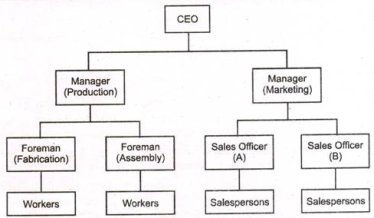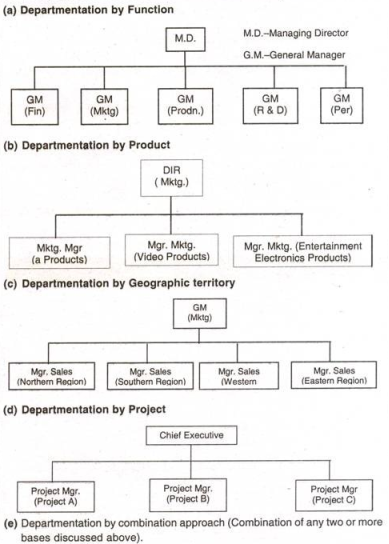Unit 4
Organizational Processes
The more complex and larger the business, the more important and complicated the structure becomes. There is no single ideal organizational structure. Organizations depending on their necessity and concept may use the structural concept which is best suited for the organization. However, the different types of organizational structures that may be used are illustrated below:

Functional Structures
- This structure is based on the different functions that are evident in an organization.
- Different functions such as marketing, finance, human resources and Internet Technology each have their own department and each department focuses exclusively on that function.
Divisional Structure
- Divisions are mini-companies built around particular products or regions.
- Each division contains all the functions necessary to handle business for that region or product line.
- The downside is that every division duplicates the same functions which are often wasteful.
Process Structure
- It divides up the organization around processes, such as research, manufacturing and sales.
- A process-based organization considers how the different processes relate to each other and the customer.
- They are geared to satisfying the customer, the end result of all the processes but they only work if managers understand how the different processes interact.
Matrix Structure
- It is often overlaid on top of a company's functional structure to tackle projects that involve multiple departments.
- It offers companies flexibility and a better use of resources than a purely functional model.
- It is the combination of two types of organizational structures. There are two chain of commands and hence the project team members have to report to two bosses or authorities.
1. Line Organizational Structure:
It has only direct, vertical relationships between different levels in the firm. There is only line departments which are directly involved in accomplishing the primary goal of the organization. This type of structure is evident in Military Organization.

2. Staff or functional authority structure
The jobs or positions in an organization are:
(I) Line position:
A position in the direct chain of command that is responsible for the achievement of an organization’s goals. The line employees are key persons of an organization who are solely responsible for their duties.
(ii) Staff position:
A position intended to provide expertise, advice and support for the line positions. The staff employees are employed only to assist the line members. They do not have any authority as regards decision making. They can only advice the line members, provide support as per their skills and knowledge.

3. Line and Staff Organizational Structure:
Some organizations have direct, vertical relationships between different levels and also specialists responsible for advising and assisting line managers. Such organizations have both line and staff departments. Staff departments provide line people with advice and assistance in specialized areas.

4. Divisional Organizational Structure:
In this type of structure, each organizational function is grouped into a division. Each division will consist of all the resources and support services needed to perform its operations. However, the various divisional structures may be in the form of:
(I) Function,
(ii) Product,
(iii) Geographic territory,
(iv) Project and
(iv) Combination approach.

5. Project Organizational Structure:
It facilitate establishment and distribution of authority for vertical coordination and control rather than horizontal relationships. Its work process may flow in any direction of work depending upon the distribution of talents and abilities in the organization.

6. Matrix Organizational Structure:
It is designed to achieve specific results by using teams of specialists from different functional areas in the organization.

Organizational culture refers to the common values, policies, practices observed by the organizational members as guidance in the organization activities. The different types of organizational culture that may be evident are:
- Normative Culture: In this, the norms and procedures of the organization are predefined and the rules and regulations are set as per the existing guidelines.
- Pragmatic Culture: In this, more emphasis is placed on the clients and the external parties. Customer satisfaction is the main motive of the employees in a pragmatic culture.
- Academy Culture: Here, organizations follow academy culture hire skilled individuals. The roles and responsibilities are delegated according to the back ground, educational qualification and work experience of the employees.
- Baseball team Culture: In this, the employees are considered as the most treasured possession of the organization. The employees are the true assets of the organization.
- Club Culture: Here, organizations follow a club culture and are very particular about the employees they recruit. The individuals are hired as per their specialization, educational qualification and interests.
- Fortress Culture: These are the organizations where the employees are not very sure about their career and longevity. Here, the employees are terminated if the organization is not performing well.
- Process Culture: In this, the employees adhere to the processes and procedures of the organization. Feedbacks and performance reviews do not matter much in such organizations.
Meaning
Organizational change means any change that occurs in the work environment. It is an important characteristic of most organizations. An organization must adapt to change or else it would be either left behind or be swept away by change. Organizational change is unavoidable in a progressive culture. Modern organizations are highly versatile, dynamic and adaptive to changes.
It may also refer to the alteration of structural relationships and roles of people in the organization. It is largely structural in nature. There are several ways to change an enterprise. Its technology can be changed; its people, its structure and other elements can be changed. Organizational change also needs for a change in the individual behavior of the workers.
Enterprises grow, survive or decay depending upon the changes in the behavior of the employees. Most of the changes can disturb the equilibrium of situation and environment in which the individuals or groups exist.
Factors in Organizational change
(A) External Pressures:
I. Change in Technology and Equipment:
Advancements in technology is the major cause (i.e., external pressure) of change. Each new technology results in the changes in the working of organization to meet and match the needs.
Ii. Market Situation:
A change in market situation refers to the rapidly changing of goals, needs and desires of consumers, suppliers, unions etc. If an organization has to survive, it has to cope with changes in market situations.
Iii. Social and Political Changes:
Organizational units literally have no control over social and political changes in the country. Relations between government and business or drive for social equality are some factors which may compel for organizational change.
(B) Internal Pressures (Pressures for Change from Within the Organization):
I. Changes in the Managerial Personnel:
One of the most frequent reasons for major changes in the organization is the change of executives at the top. No two managers have the same style, skills or managerial philosophies.
Ii. Deficiencies in the Existing Organization:
Many deficiencies are noticed in the organizations with the passage of time. A change is necessary to remove such deficiencies as lack of uniformity in the policies, obstacles in communication, any ambiguity etc.
Process of planned change
Unless the behavioral patterns of the employees change, the change will have a little impact on the effectiveness of the organization.
A common model for bringing change in people has three phase process:-

(1) Unfreezing:
The basic sense of unfreezing phase is that the individual is made to realize that his feelings, beliefs and behavior are no longer relevant to the current situation in the organization. Once convinced, people may change their behavior. Reward for those willing to change and punishment for others may help in this matter.
(2) Changing:
Once an individual is convinced and ready to change then he learns to behave in new ways. He is initially provided with the model in which he is to recognize himself. Later he will accept the model and behave in the manner suggested by it. In another process (known as internalization), the individual is placed in a situation where new behavior is demanded of him if he is to operate successfully.
(3) Refreezing:
In this phase, an individual has to practice and experiment with the new method of behavior and see that it effectively blends with his other behavioral attitudes.
References:
- Organizational behavior by Stephen P. Robbin & Seema Sanghi- pearson
2. Organizational behavior by L.M. Prasad-S Chand & sons
3. Organization behavior: managing people and organization by Gregory moorehead – Biztantra